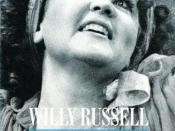Doris Lessing's To Room Nineteen and the movie Shirley Valentine shared some feminist concepts but differed in the presentation of emotion, the stereotypes and the women's solution to their captivity.
To Room Nineteen's mother Susan is trapped by her house, children and constant responsibility. While Susan is slowly going mad under the pressure, Lessing's writing style remains distant and passive. Lessing may take this approach to capture the insanity and distance that Susan felt toward her family; however, the overall style comes across as robotic, lacking any emotion at all. At one point in the story, Susan longingly peers into her own house as Sophie cares for Susan's sick daughter. But even at this moment of realization that her family is lost, I found that Susan had no emotion. Susan is too distant; in lacking any emotion, it is difficult to empathize with her. However in the movie Shirley Valentine, the style and characterization is quite opposite.
It is easy to empathize with Shirley. She is funny and likeable. The viewer can become attached to her and feel her sadness. When Joe pushes the chips and egg into Shirley's lap, the viewer feels angry because Sherry has become their friend. In To Room Nineteen Matthew takes a lover, a far greater crime than pushing chips and egg, but it has less feeling because Susan has no emotion of her own.
Feminist stereotypes also come across in both stories, but in very different ways. In Shirley Valentine, the stereotype is that to make a woman's inside more beautiful, her outside must become more beautiful as well. As Shirley's time in Greece goes on, she becomes more and more fashionable, more outwardly beautiful. Maybe it is an attempt to show her confidence, and that after 20 years she finally cared...


